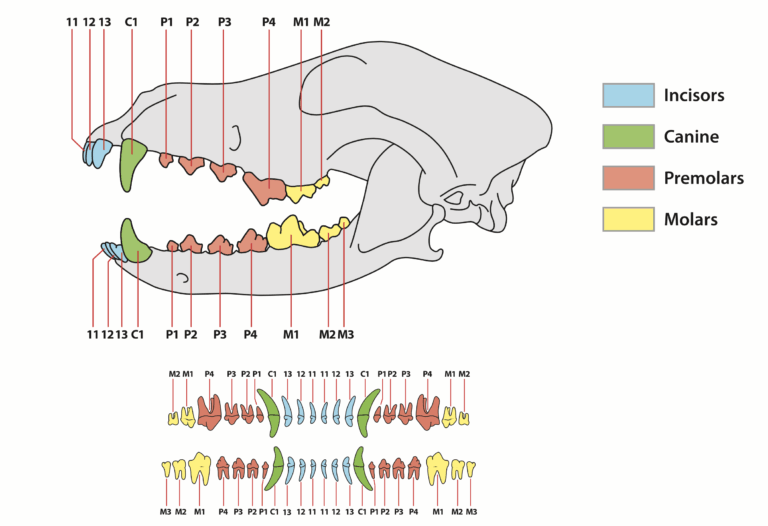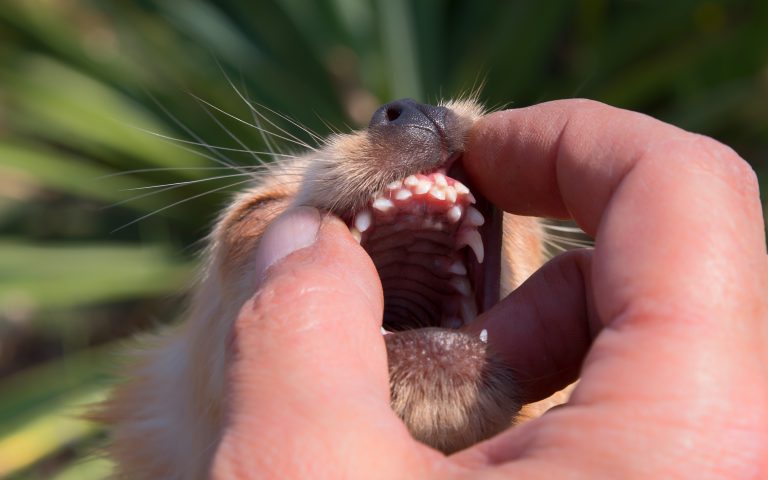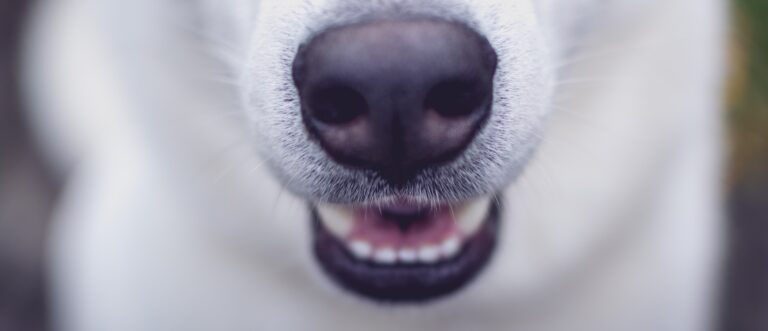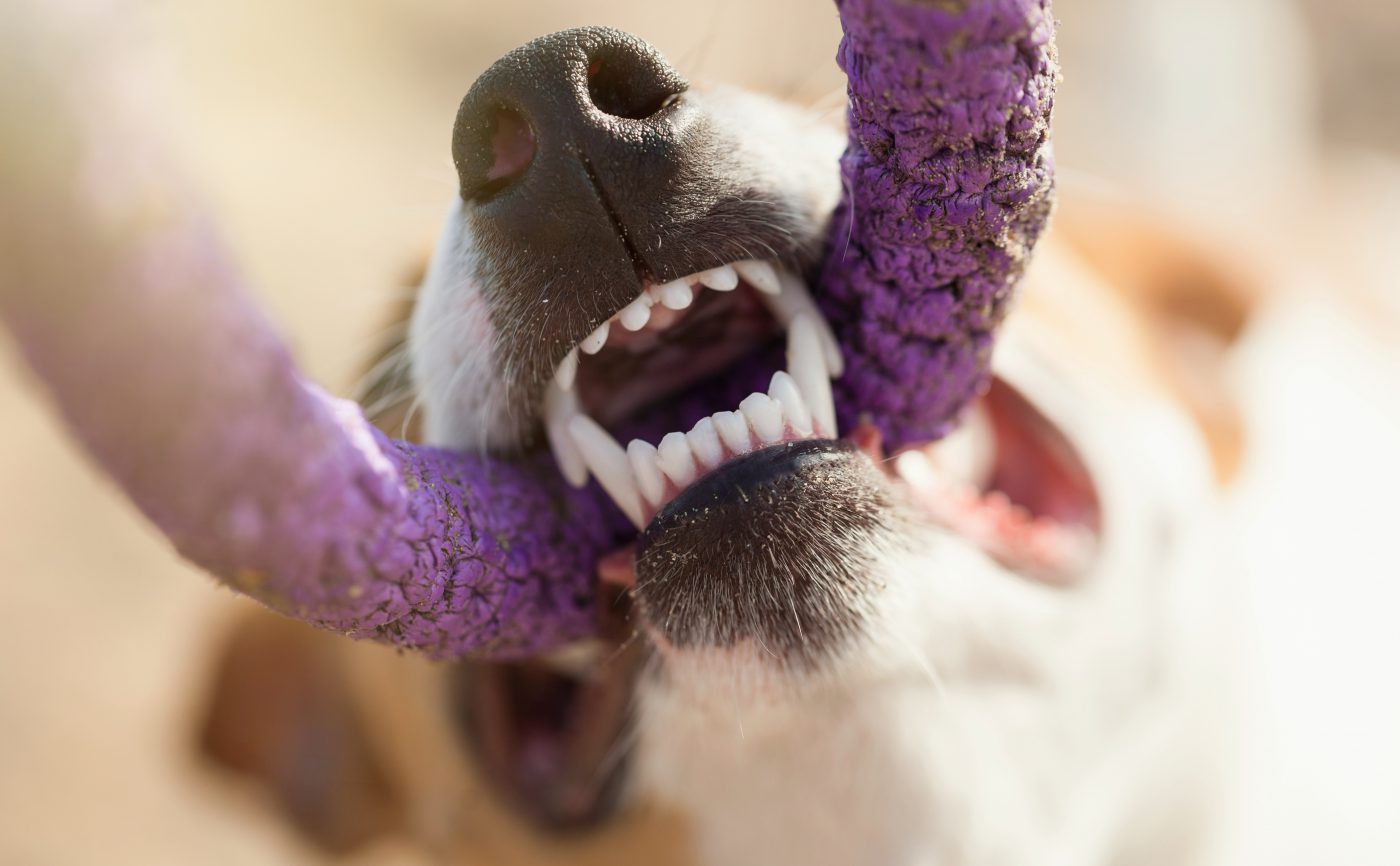Dental care is an often overlooked but essential component of dog ownership. As with humans, dental care isn’t just about how your dog’s teeth look but about preventing and sometimes predicting larger, more serious health problems. Daily brushing, regular observation of the state of your dogs’ gums, and professional cleanings can help your dog live a happier and healthier life.
But because it’s such an overlooked part of dog health, it’s important to start with the basics of what’s going on with your dog’s mouth throughout their life. From the time they’re born until they’re fully grown, dogs experience massive changes in their dental development which can lead to serious complications.
In fact, approximately 80%of dogs suffer from dental disease by the time they’re 3 years old.
To understand what’s really going on in your dog’s mouth, it’s important to go back to basics: how many teeth does your dog have? What is canine dental development like? What should you expect from a puppy of four weeks versus an adult of two years? Are there special considerations for different breeds?
Here’s what you need to know about your dog’s teeth.
How many teeth do dogs have?
The number of teeth your dog has depends on their age. Puppies, for example, only have 28 deciduous (puppy or baby) teeth, while all fully grown adult dogs, no matter their size, have at least 42 teeth. That means that both mastiffs and Chihuahuas have 42 teeth in two wildly different mouths.
There is one notable exception, however: chow chows, one of the oldest breeds in the world, have an extra pair of molars, giving them 44 teeth.
Not all 42 teeth are created equal, though. Anyone who has ever looked at a dog’s mouth knows that, much like us, they have different types of teeth for different purposes. In fact, you can see evidence of their omnivorous diet and their predator status in their teeth.
The types of teeth dogs have

Incisors: Small front teeth, used for scraping at meat, and grooming. Dogs have 6 on top and 6 on bottom
Canines: Sharp, fang-like teeth used for puncturing and holding. Dogs have 2 on top, 2 on bottom
Premolars: Set behind the canines, these teeth have sharp edges and flat surfaces. Meant for chewing on the side and shearing. Dogs have 8 on top, 8 on bottom
Molars: Large, flat teeth in the back meant for crushing, grinding and chewing. Most dogs have 4 on top, 6 on bottom
Tooth development throughout a dog’s life
Of course, no dog comes out of the womb with all 42 teeth—just as no human is born with a full set of chompers.
In fact, puppies don’t start developing their first set of teeth (called deciduous, puppy, or milk teeth) until they’re about three weeks old. (And yes, puppy teeth are sharp—often compared to razors—to compensate for their lack of jaw strength.)
Generally speaking, the incisors and canines develop first, followed by the premolars. Molars and the first premolars are never deciduous; they only appear as permanent teeth later in the developmental process. Most dogs will have all 28 of their puppy teeth by the time they’re six weeks old.
Anyone who has ever raised a puppy is familiar with the stage of growth where you start finding puppy teeth scattered here and there throughout the house, a sign that their razors are being replaced by their comparatively dull permanent teeth.
A dog’s permanent teeth will start to appear around 4 to 5 months of age, and it takes about 2 to 3 months for their puppy teeth to be replaced by all 42 adult teeth. But you likely won’t find 28 baby teeth scattered about: it’s very common (and quite safe) for dogs to swallow their puppy teeth while eating or teething.
If, by 6 or 7 months of age, your dog still has any deciduous teeth remaining, you should see a vet immediately; these are called retained deciduous teeth and they can cause serious problems if they’re not removed right away. Retained teeth can cause overcrowding and tooth loss down the line and are especially common in small dog breeds.
Small dogs: a special dental challenge

Retained deciduous teeth in a small dog’s mouth
If you have a small-breed dog (25 pounds and under), there are additional factors to consider when it comes to their dental health. Small dogs, quite obviously, have smaller mouths than their medium- and large-sized companions; but they have to fit the same 42 teeth in that smaller space. That leads to overcrowding, which can create an environment ripe for periodontal disease—inflammation and infection of the gums. Periodontal disease is the most common dental health issue facing all dogs, but it’s more common and often starts much earlier in smaller dogs,
Further, some small brachycephalic breeds, such as French bulldogs, often have undersized teeth, sideways teeth, or even misaligned jaws, which make it both easier for gum disease to develop and more difficult to care for your dog’s teeth.
To prevent periodontal disease and its related ailments, it’s important to start a daily dental health routine.
The importance of taking care of your dog’s teeth

As with humans, canine dental care is about so much more than dazzling, white teeth. Poor dental health can pave the way for other health problems and can lower your dog’s quality of life.
Poor dental hygiene can cause tooth decay, which can lead to bad breath, discomfort, and even tooth loss. But more importantly, dental disease is linked to other health problems, including heart disease. The bacteria that causes gum disease can get into the bloodstream and negatively impact the heart and other organs like the kidney and liver, and trigger inflammation.
One way to monitor your dog’s dental health is by checking their gum color. (Read more about gum color here.) As with humans, bright red gums are often the first sign of gingivitis, or gum disease, which, if left untreated, can lead to tooth loss, and, over time, may be associated with kidney, liver, and heart disease. (It can even cause insulin resistance in dogs with diabetes.)
The only way to prevent and/or treat dental disease is to keep up with dental health checkups with your vet, and by brushing your dog’s teeth every day or at least a few times a week. The best way to make brushing a habit is to teach your dog to associate tooth brushing with a positive experience, like receiving a treat, and to introduce the process slowly.
And, no, kibble doesn’t clean teeth, despite the persistent belief that it does. In fact, the starchy food can actually contribute to plaque build-up and the development of dental disease, so read our guide to brushing your dog’s teeth and start creating a positive routine with your four-legged friend today.









